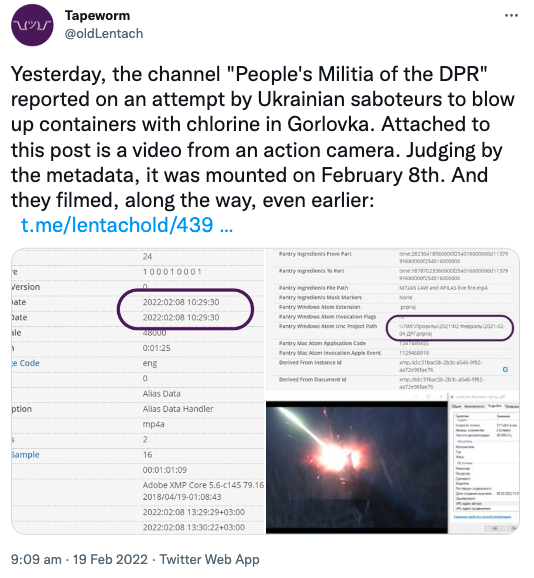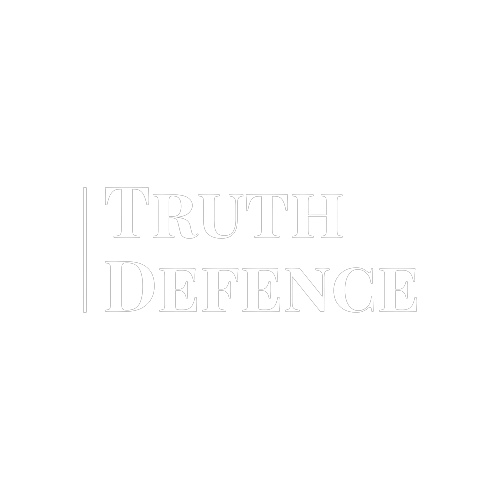Truth Defence has compiled a database of unproven, unverified and untrue claims from the war in Ukraine that is critical of disinformation on all sides. We have begun mapping these on the timeline below. This is by no means a comprehensive or exhaustive list but we will continue to updated it retrospectively and as new claims emerge.
Each claim has been colour coded: anything marked amber has been identified as unverified, unproven or unprovable and anything marked red is provably false. We have not included links to news articles that we have identified as misinformation in order to avoid amplifying falsehoods, unless the reporting itself is required to provide the original source of a claim. Please be warned that this page contains highly sensitive and graphic descriptions of events, though we have minimised graphic imagery on the page, there may be links included which some readers may find disturbing.
Russian MoD in a Telegram claimed:
“Against the backdrop of military defeats in Donbass and elsewhere, the Zelenskyi regime sanctioned terrorist acts involving the use of chemical poisoning substances against Russian servicemen and civilians… On July 31, Russian servicemen carrying out tasks near Vasil’evka, Zaporizhzhya Region, were taken to a military hospital with signs of severe poisoning. As a result of examination, toxic substance, botulinum toxin type B, was found in servicemen’ organisms.”
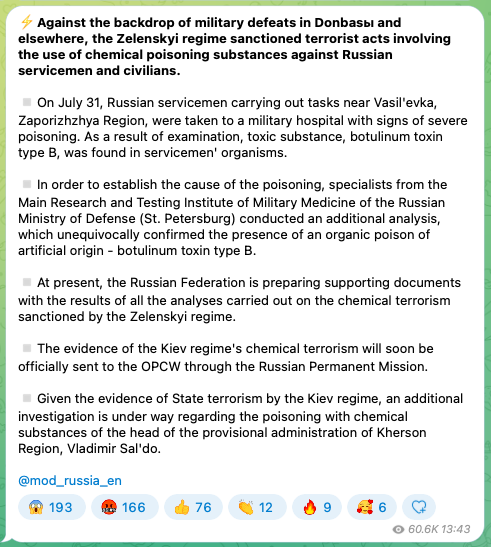
Russia did not state how many servicemen were affected or what evidence they have to support the accusation, but said that they intend to send samples to the Organisation for the Prohibition of Chemical Weapons (OPCW).
While no official response has been given by the Ukrainian Ministry of Defence, Anton Gerashchenko, Ukraine’s interior ministry adviser responded to coverage by Russia state-owned news channel RIA Novosti on Telegram, saying:
“The agency (Russian MoD) does not clarify whether the poisoning could have been caused by expired canned meat, which often contains botulinum toxin. The army of invaders complained massively about expired rations from the first days of the invasion of Ukraine.”
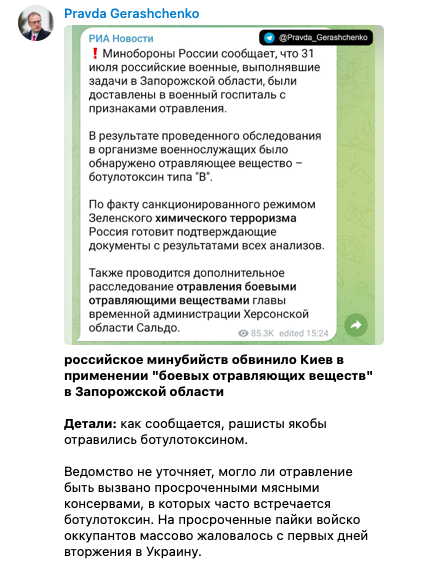
Botulinum toxin type B is produced by a bacteria called Clostridium botulinum and causes muscle paralysis. It is a toxin that causes a life-threatening type of food poisoning called botulism, which occurs when when someone eats food containing the toxin because it hasn’t been properly canned, preserved or cooked. Because of its extreme toxicity and ease of production it was one of the first agents to be considered for use as a biological weapon. A deliberate release of botulinum toxin could be in the form of an aerosolised weapon or contamination of a food or water supply.
As well as the reporting by RIA Novosti, Russia’s claims have been reported as fact by PressTV (Iran).
The assertions made by Gerashchenko have also been reported matter of factly by the Express, who reported that the Russian servicemen had been “afflicted by yet another food poisoning calamity, as Russia points finger at Ukraine.”
A video claiming to show Ikanders (Russian ballistic missiles) moving to Vyborg, where Russia borders with Finland, in response to Finland’s NATO bid, went viral on Facebook and Twitter. The video, which was filmed by a Russian man on a highway passing by seven Russian military vehicles and shared to Facebook by an American musician, racked up thousands of likes and comments before it was marked as ‘Partly false information’ by Facebook.
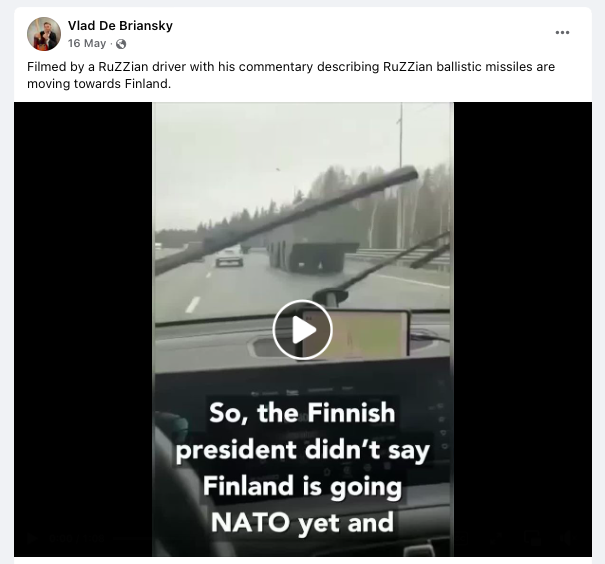
Reuters reports that they interviewed two military experts to explain the true contents of the video, Joseph Dempsey, who is research associate for defence and military analysis at the International Institute for Strategic Studies and Pavel Podvig, a senior researcher in the Weapons of Mass Destruction Programme at the United Nations Institute for Disarmament Research. Dempsey told Reuters that the video actually shows a Bastion coastal defence missile system, pointing out that while both vehicles for transportation use a similar framework, they are several differences, for example “the smoother bodywork and greater rear overhang of the Bastion launcher”.
Dempsey added: “Unlike the dual-capable land attack ballistic and cruise missiles associated with the Iskander system, the P-800 Oniks (Bastion system) is assessed to be able to carry a conventional explosive warhead only.”
Reuters reports that Podvig “echoed Dempsey” but pointed out that “the US Missile and Space Intelligence Center’s (MSIC) Defense Intelligence Ballistic Missile Analysis Committee (DIBMAC) believes the 3M-55 could be “nuclear possible”, adding “Even if this is the case, the missiles would not be normally equipped with nuclear warheads – the standard practice for systems of this kind is to be deployed as conventional.”
Their comment suggests that the video is likely wrongly subtitled. A spokesperson for the Finnish Defence Forces told Reuters: “It is completely normal for Russia to move different kinds of weapon systems to its borders.”
Multiple Western news publishers have reported the claims made in the video as fact, including the New York Post, Metro, Sky News Australia, Express, news.com Australia and The Sun, who ran with the headline: “BORDERING ON WAR Russia ‘deploys nuke missiles’ to border with Finland in chilling threat over country’s NATO bid”.
During a segment on state-owned TV channel Russia-1, anchor Dmitry Kiselyov claimed that Russia’s nuclear torpedo Poseidon is capable of producing a “nuclear tsunami” that would turn the UK into a “radioactive desert”. The segment includes a demonstrative video that appears to show how the weapon would work and the path that it would take.
“Another option is to plunge Britain into the depths of the sea using Russia’s unmanned underwater vehicle Poseidon… It approaches its target at a depth of 1km, at a speed of 200km per hour. There’s no way of stopping this underwater drone. The warhead on it has a yield of up to 100 megatonnes… The explosion of this thermonuclear torpedo by Britain’s coastline will cause a gigantic tsunami wave, up to 500m high. Such a barrage alone carries extreme doses of radiation. Having passed over the British Isles it will turn whatever might be left of them into a radioactive desert.”
Several defence experts have debunked Kiselyov’s claim. On his website ‘Covert Shores’, defence analyst H I Sutton, who specialises in submarines and sub-surface systems, states that “Poseidon is to be taken very seriously. But this video should not. It contains errors and repeats unsubstantiated claims and hyperbole.” Sutton points out that the details presented by Kiselyov are incorrect and that the accompanying demonstrative video was created by Russia-1 staff rather than an “informed source” and contains inaccurate, “hastily gathered source material.”
“The segment repeats exaggerated specifications. This includes a claimed 100 megaton warhead which it says will create a 500 meter high tsunami. This has its roots in Russian media articles immediately following the November 2015 unveiling of Poseidon (then called Status-6). These articles appear speculative at best. Newer estimates for the warhead size is around 2 megatons.”
The Poseidon was first revealed in 2015 in a ‘leak’ on Russian state TV, which the CIA has since concluded was intentional, when the plans for the a torpedo that was then codenamed ‘Status-6’ were briefly broadcast. The diagram shown in the broadcast contained the technical details for a giant torpedo with a range of “up to 10,000km” and a depth of “up to 1,000m”.
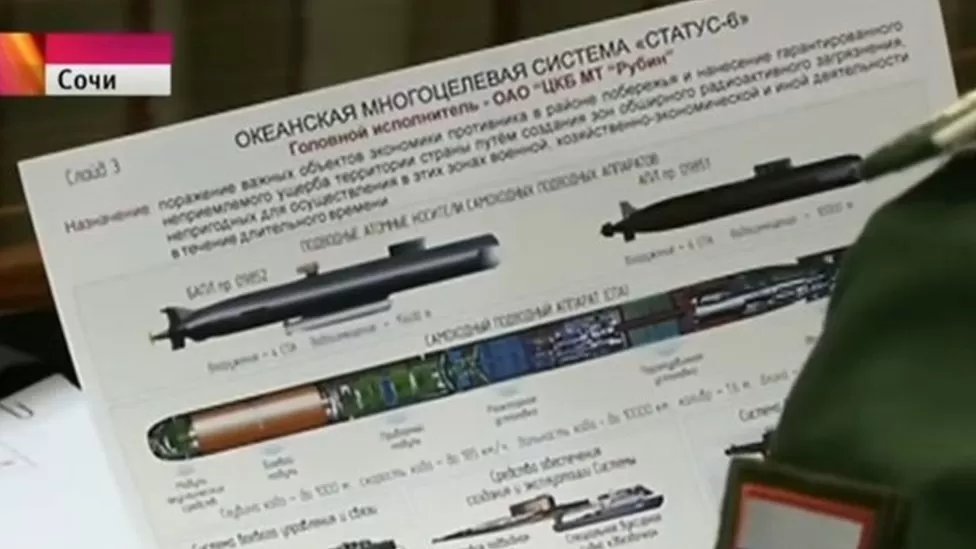
It was reported by Russian state media at the time that the size of the Status-6 would be up to 100 megatonnes. However, in 2018 when Poseidon was named and first acknowledged in an official capacity by the Pentagon, US and Russian officials put the size of its warhead closer to 2 megatonnes – in May 2018 Russian News Agency TASS reported that “a source in the Russian defense sector” had confirmed this.
David Hambling, a technology journalist specialising in defence told Euronews:
”We know that from quite a lot of work which was actually done again back in the crazy days of the Cold War about doing this very thing, and creating tsunamis with nuclear weapons… It turns out you need a vast amount of energy to do that – even more than you can get out of a nuclear blast… If it’s moved into a harbour and detonated very close offshore, it would certainly be able to destroy a city. But it probably wouldn’t damage much beyond that, and it certainly wouldn’t do as much damage as a large nuclear airburst.”
His analysis is mirrored by another defence analyst interviewed by Euronews, Sidharth Kaushal, who is “a research fellow for seapower and missile defence at the UK defence and security think tank RUSI”. Kaushal told Euronews that Poseidon could “certainly render a coastal city uninhabitable,” or destroy “a good part of a carrier battle group at sea… It could wipe out a coastal city but not the UK as a whole.”
On 3 May, The Mirror published an article titled “Putin’s UK nuclear threat ‘horrific’ and shows Russia ‘disinhibited’, says expert”, in which security analyst and retired army officer, Tom Clonan states:“The simulation shows what they call a Poseidon nuclear underwater drone which has a warhead of up to about 100 megatons… This would create such a shockwave and a blast that it would create a tsunami of 500m tall that would sweep over Ireland and Britain.”’
Clonan appears to be responding to the claims made within the video rather than from a place of knowledge about the Poseidon missile itself – he repeats the outdated claim that Poseidon has a warhead yield of 100 megatonnes and uses this to form the basis of his analysis, which contradicts the analysis of other defence experts who have said that a 2 megaton warhead would not have the power to substantiate the claims made by Kiselyov.
In July, when Russia received its Belgorod submarine, which is carrying 6 Poseidon torpedos, the claims made by Russia-1 were published unchallenged in an article by Express: “Dmitry Kiselyov, the anchor of a Russian state-television show, warned that Moscow’s Poseidon drone can trigger a giant 500-metre tidal wave of radioactive seawater that could batter Britain and turn it into a wasteland.”
It was reported on 14 April by Reuters that a statement had been put out by the Defence Ministry in which it claimed that the source of the fire had been contained and the ship remained afloat. Later that day, TASS reported that the ship had sunk whilst being towed in a storm. “During the towing of the Moskva cruiser to the designation port, the ship lost stability due to hull damage, sustained during the detonation of ammunition because of a fire. Amid the heavy storm, the ship sank,” they quoted the Defence Ministry as saying.
Hours prior to the initial claims by Russia’s Defence Ministry, a Ukrainian official had stated that the ship had been hit by Ukrainian missiles. In a message posted to Telegram on 13 April by the head of the administration of the Odessa region, Maxim Marchenko, he states: “It was confirmed that the missile cruiser “Moskva” today went exactly where it was sent by our border guards on Zmiiny Island! “Neptune” missiles guarding the Black Sea caused very serious damage to the Russian ship. Glory to Ukraine!”
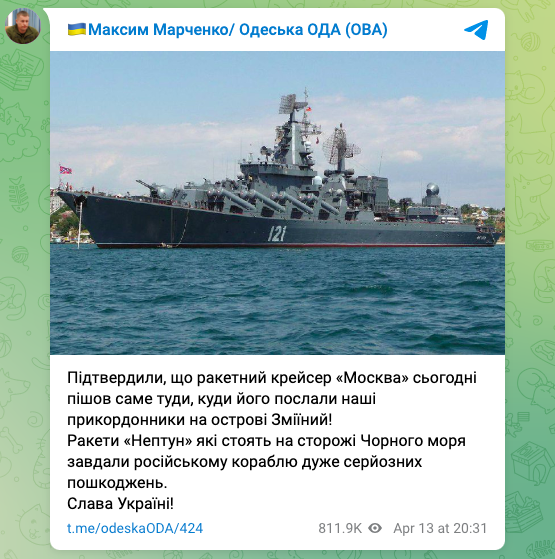
Pentagon press secretary, John Kirby, stated that the Pentagon could not confirm or deny the claims either way. “We cannot confirm the Ukrainian reports that it was hit by a missile, but we are also not in a position to refute that, that it could have been a Ukrainian missile which struck the ship,” said Kirby in a press conference at the Pentagon. On 15 April, The Washington Post and The New York Times both reported that an unnamed senior U.S. defence official had confirmed Ukraine’s version of events, that Moskva was hit by ‘two Ukrainian-made anti-ship missiles’. The South China Morning Post, stated in an article that reporters had been briefed “on condition of anonymity.”
The following day, 16 April, the Russian Defence Ministry posted a video to Facebook, which depicts the head of the Russian navy, Admiral Nikolai Yevmenov and what has been claimed are survivors of Moskva, the caption translates as: “Commander-in-Chief of the Navy Admiral Nikolay Evmenov and the Black Sea Fleet Command held a meeting with the crew of the rocket cruiser “Moscow” in Sevastopol.” There were around 150 servicemen in the video posted by the Defence Ministry, who had not at this point corrected their claim that all servicemen had been evacuated from the the ship.
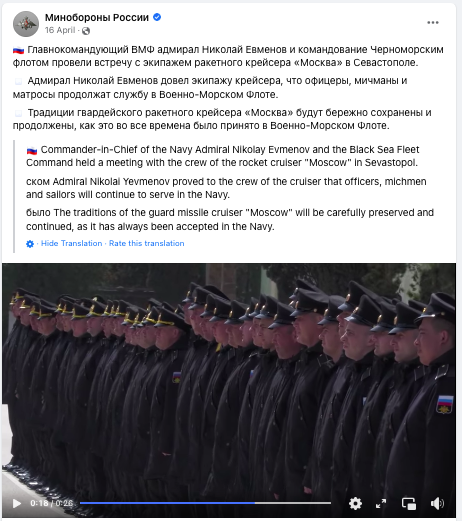
On 17 April, the first images and footage emerged of the damaged missile cruiser, which showed the seriously damaged Moskva on calm water. In an article by Naval News, they have published what they say are images depicting the wave and wind status at the time the Moskva was being towed, which refutes the Russian Defence Ministry’s claims that the ship sunk while being towed due to stormy weather.
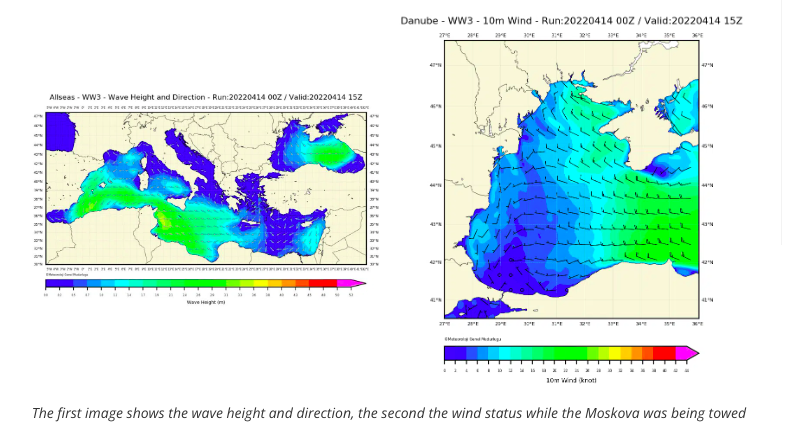
On 18 April, the Russian Defence Ministry released a statement which claimed that “one serviceman died, 27 more gone missing in action… The remaining 396 crew members were evacuated from the cruiser to nearby Black Sea Fleet ships and delivered to Sevastopol.” This was the first time Russia had admitted that crew members from Moskva had died. There has, as of 11 July 2022, been no official confirmation about the crew.
Numerous family members have come forward to say that they have been kept in the dark about the whereabouts of their relatives who were serving aboard the Moskva at the time that it sank. In an article published by Metro on 8 June, the mother of a Russian conscript who was likely killed when Moskva sank, says that she has still not received any official confirmation of what happened to her son. She also alleged that Russian authorities have blackmailed family members and said that she was told she would only be given compensation if she signed her name in agreement that Moskva was not hit by Ukrainian forces.
Reporting
As well as the reporting by Russian News Agency, TASS, Russia’s version of events have been reported as fact by Al Mayadeen (Lebanon) and Trend News Agency (Azerbajan).
A message published to the Azov Battalion Telegram channel claimed that Russia had used an unknown toxic substance in Mariupol against Ukrainian military as well as against civilians and reported victims were suffering from respiratory failure and “vestibulo-attack syndrome”.
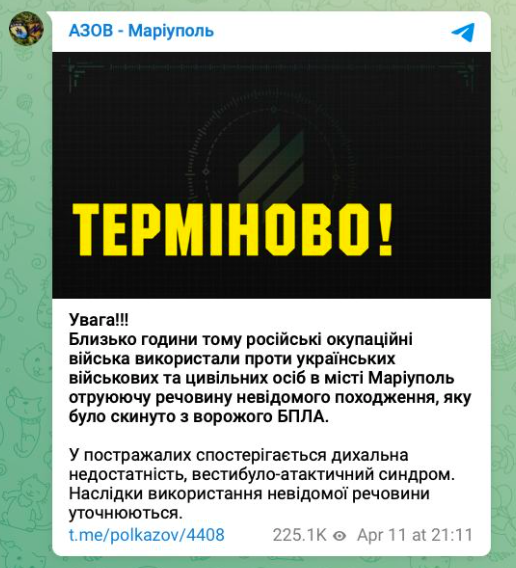
Azov Battalion posted a subtitled video to their Telegram channel on 12 April, which claims that “a poisonous substance of unknown origin” had been used the day prior and the symptoms they had observed: “They are among hyperaemia, high blood pressure, dryness and inflammation of the faucet (throat), eye mucous membranes.” Individuals in the video also described a “fog” or “white smoke” and how they began feeling the symptoms almost immediately.
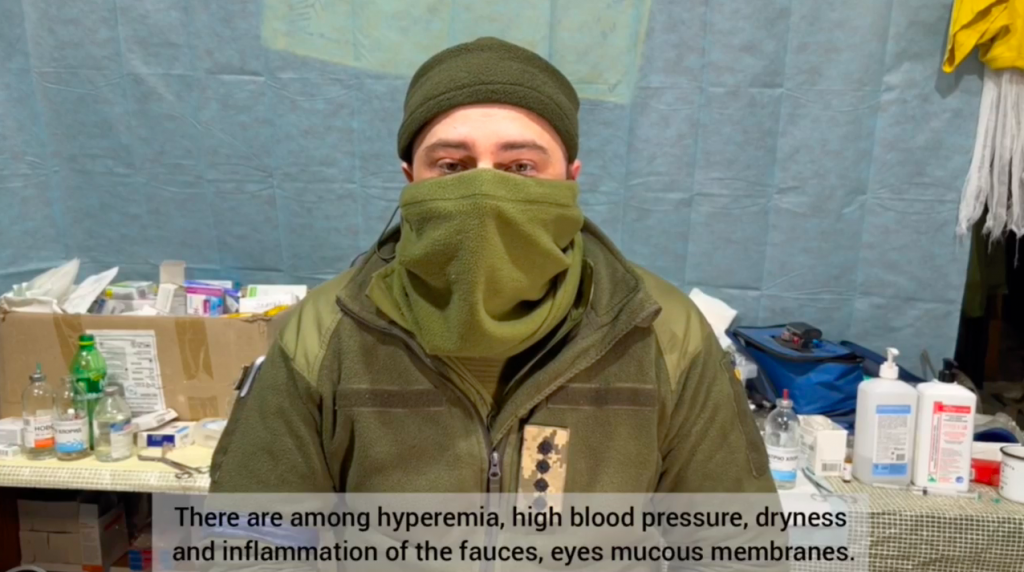
A message was also posted to the channel, which states “It is clear now that the enemy has used the poisonous substances or potent poisonous substances, mainly the suffocating ones. However, due to a complete blockade the toxicological analysis is impossible.”
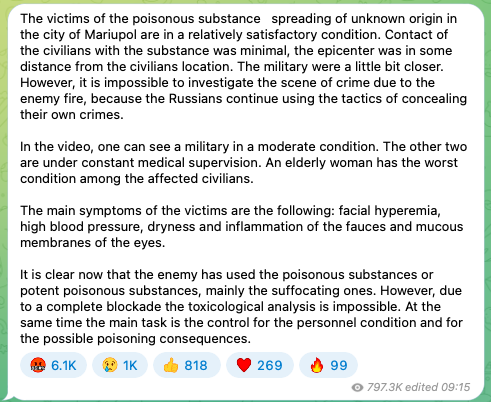
Chemical weapons expert Dan Kaszeta, who is the author of ‘Toxic: A History of Nerve Agents from Nazi Germany to Putin’s Russia’ has shed doubt on the claims. In a series of tweets he questions why specific medical phrasing such as “vestibulo-attack syndrome” was used in the initial reporting of the attack and also highlighted that the symptoms listed by Azov would point away from the use of nerve agents:
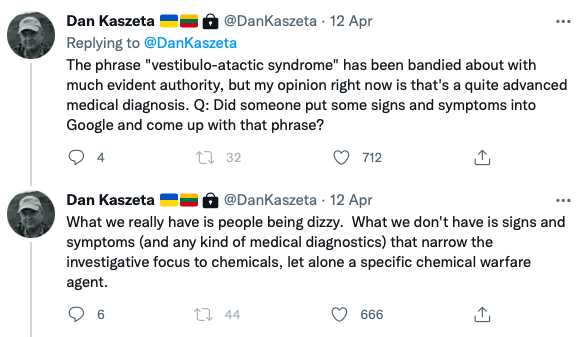
Both the US and Ukraine have been unable to verify the claims and only three alleged victims have been recorded who claim to have experienced symptoms.
Reported as fact by Express with the headline ‘Chemical weapon’ horror as Putin drops ‘poisonous substance’ on city – ‘People suffering’
Daily Mail covered the story, specifying that the information is unverified but its headline implies otherwise: ‘Russia ‘unleashes chemical weapons on Mariupol’: Liz Truss threatens to go after Putin following claims Ukrainian troops were hit by substance dropped from a drone that left them unable to breathe – just as Zelensky warned Moscow plans to use them’
GB News posted a video to YouTube of a live segment of their show titled ‘IT’S IMPOSSIBLE TO BREATHE | Reports emerge of Russian chemical attacks in Mariupol’, in which they state that the claims came from ‘Ukrainian military’ without specifying that the claims came directly from the Azov Battalion. Within the segment journalist Stefan Weichert states that it is “unclear whether the claims are verified or not.” At this time there was no verification of the claim (and this is true almost 5 months along – true as of 7 Oct 2022).
In interview with BBC News published 11 April, they report the former Ukrainian human rights ombudsman, Lyudmila Denisova’s claim: “About 25 girls and women aged 14 to 24 were systematically raped during the occupation in the basement of one house in Bucha. Nine of them are pregnant… Russian soldiers told them they would rape them to the point where they wouldn’t want sexual contact with any man, to prevent them from having Ukrainian children.”
In May, a letter signed by 140 ‘Ukrainian media women’ was sent to Denisova, which raises serious concerns about her communications with the media about the use of sexual violence as a weapon of war in Ukraine. “Sex crimes during the war are tragedies of families, a difficult and traumatic topic, and not a topic for publications in the spirit of a “scandalous chronicle”. It is necessary to remember the goal: drawing attention to the facts of crimes.” The letter goes on to ask that Denisova “Publish only that information for which there is sufficient evidence; check facts before publishing.”
Lawmaker Pavlo Frolic accused Denisova of pushing misinformation of “numerous details of ‘unnatural sexual offences’ and child sexual abuses in the occupied territories, which were unsupported by evidence”, which he says has “only harmed Ukraine” and distracted media attention away from other provable war crimes. Days after she was removed from her position Denisova admitted to “exaggerating” claims in an interview with LB News. “I tried to achieve the goal of convincing the world to provide weapons and pressure… There is a party, Five Stars, which was against the provision of weapons to us, but after my speech, one of the party leaders expressed support for Ukraine, said that they will support, including the provision weapons,” Denisova said.
Denisova’s is quoted as a source in hundreds of news reports and her name appears side by side with the genuine first hand accounts of victims and witnesses of sexual war crimes in Ukraine. Her words have already been used to cast doubt on the authenticity of real victim’s testimonies and have undermined the fact that rape at the hands of Russian troops is a systemic problem. The story has been covered by Sputnik and Russia Today, as well as by right wing outlets who have wrongly asserted that the allegations of systemic sexual violence have relied chiefly on her testimony.
While there is undeniable evidence that Russia is using sexual violence as a weapon of war in Ukraine – hundreds of victims and witnesses have come forward with their experiences – Denisova has muddied the waters and undermined real victims by spreading false and unverified information. This is one of many claims made by Denisova and appears to be the most severe. It may be true, partially true, or entirely false.
Denisova’s claims have been reported by the following news outlets, most of which rely on her interview with BBC as their source: Yahoo News, Business Insider, New York Post, The Washington Post, The Guardian, New Statesman, iNews, The Sun, The Mirror, Daily Mail, Daily Star, The Express, NPR, The Week, Lad Bible Kyiv Independent, Ukraine Media Crisis Centre, Front News Ukraine, etc.
The claim that Russian forces are using “mobile crematoriums” to hide the full extent of their atrocities in Ukraine was originally made by Mariupol City Council in a Telegram, which speculated that “tens of thousands of civilians from Mariupol could have fallen victim to the occupiers”. The claim was repeated by former boxer Vitali Klitschko, in a Tweet posted 7 April, in which he shared the following image.
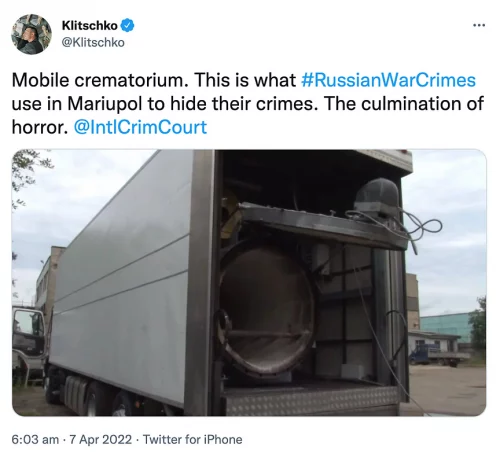
In a Telegram published 13 April, The Main Intelligence Directorate of the Ministry of Defense of Ukraine shared the same image, stating: “13 mobile crematoria were registered in Mariupol to clean the streets of the bodies of dead civilians”.
This claim is unverified and unproven [as of 20 May]. The image shared by the Ukrainian Ministry of Defence and Vitali Klitschko appears to originate from a video that was shared to YouTube in 2015, with the title ‘Mobile crematoriums used to incinerate bodies of Russian soldiers in Donbas’.
The same video was featured in a Telegraph report on 23 February, prior to Russia’s invasion of Ukraine and 6 weeks prior to Mariupol City Council’s claims, which contains speculation from UK Defence Secretary Ben Wallace, that the vehicle-mounted incinerators “could” be deployed by Russia into Ukraine. According to the Telegraph, Wallace states that “Previously [Russia have] deployed mobile crematoriums to follow troops around the battlefield” as a way to “cover up loss”. He goes on to add “It’s a very chilling side effect of how the Russians view their forces and for those of you who served, and being a soldier, knowing that trundling behind you is a way to evaporate you if you are killed in battle probably says everything you need to know about the Russian regime.”
The Telegraph and LBC both ran headlines that reported on the claims as fact.
‘Russians ‘burning bodies in mobile crematoriums to cover up Mariupol war crimes’ – The Telegraph
“The new Auschwitz’: Bodies of ‘10,000 Ukrainians’ incinerated in mobile crematoriums” – LBC.
Al Jazeera, ABC News, Yahoo News, Euronews, Business Insider and The i, have all reported on the claims without specifying that they are still unverified and unproven.
Following the withdrawal of Russian troops from the city of Bucha, the bodies of civilians were found laying in the street. Ukraine claims Russian troops executed and tortured hundreds of civilians in Bucha. The Russian Defence Ministry has denied these allegations and in a Telegram claimed that “Russian units withdrew completely from Bucha as early as March 30” and “evidence of crimes” in Bucha did not emerge until the fourth day, when the Security Service of Ukraine and representatives of Ukrainian media arrived in the town.”
A Telegram posted by a channel called ‘War on Fakes’, which was reposted by the Russian Defence Ministry, claimed to have proof that Bucha was a “planned media campaign” and claimed to have to ‘debunked’ images and video footage posted to social media, stating that the bodies depicted in a video shared to Twitter by the Ukrainian Ministry of Defence on 2 April, were ‘moving’.
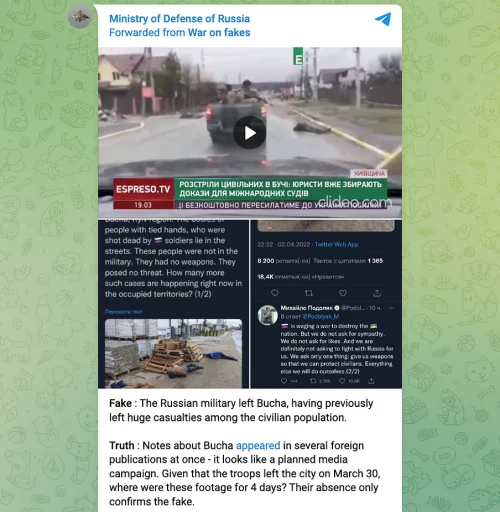
The timeline presented by the Russian Defence Ministry focuses predominantly on a video posted to the city of Bucha website and the Bucha city council social media channels, “on March 31, the mayor of Bucha, Anatoliy Fedoruk, confirmed in a video message that there were no Russian servicemen in the town, but he did not even mention any locals shot in the streets,” reads their telegram. While Fedoruk’s short video message, which was posted on 1 April, does not itself specify that there were bodies in the street, a message that was published below the video on the city of Bucha website states “All the residents of the city will hurry to share this news: who stayed at home and who was waiting for this message for hundreds and thousands of kilometers. Unfortunately, we have paid too high a price for this – human lives.” The video was uploaded to the Facebook account of Bucha city council, at 16:31, earlier that day at 8:17, a video message from the Secretary of the Bucha City Council, Taras Shapravsky, was uploaded to the same page in which he says “the city remains under occupation, many mines, houses and even corpses. Therefore, we ask those who remain not to approach dangerous objects. The liberation of the city continues, the Armed Forces of Ukraine, territorial defense are working to regain every meter of native land.”
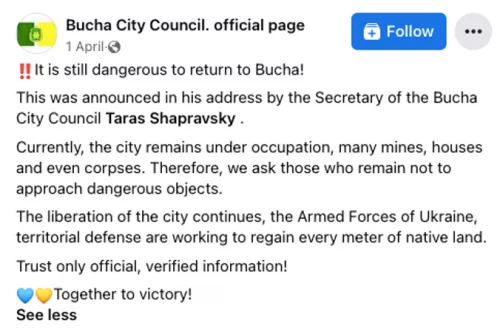
The Russian Defence Ministry’s claim that Fedoruk had confirmed in his video message “there were no Russian servicemen in the town” was also false. He makes no reference to Russian personnel but declares that “March 31 is the day of Bucha’s liberation”. In the message accompanying the video on the city of Bucha website it acknowledges that the Ukrainian military had not yet given permission for humanitarian convoys to enter the city.
The timeline presented by the Russian Defence Military, which asserts all personnel had withdrawn by 30 March does not correspond with omitted evidence; on 31 March, the head of Kyiv Oblast State Administration made a statement on Ukrainian television, in which he stated that “Ukrainian troops occupied Irpin, but neighboring cities – Vorzel, Bucha, Gostomel – are still under enemy control. They are under constant fire.” On the air of Radio Donbass.Realii on 1 April, he announced that while most of the Bucha was free from Russian troops, fighting continued in the Gostomel-Bucha-Vorzel triangle, which is consistent with the messaging put out by Bucha City Council. It wasn’t until 2 April, that the Deputy Minister of Defense Hanna Maliar and the Kyiv Regional State Administration announced that Bucha was fully liberated, which corresponds as the first day that Ukrainian Military released the now widely shared video footage of Yablunska Street.
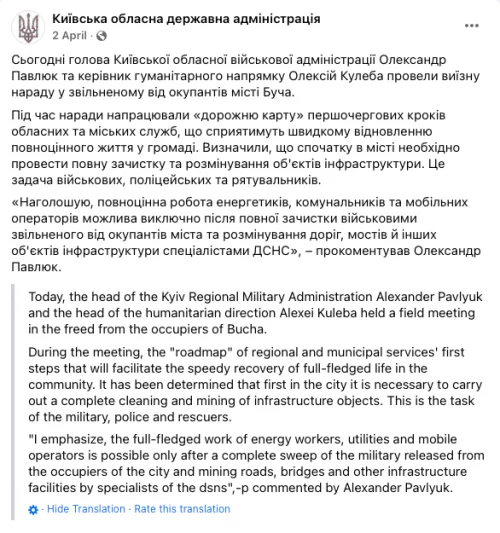
The claims made by the War on Fakes and shared by the Russian Defence Ministry, that bodies shown in footage of Bucha were ‘moving’, have also been disproven. The video, which was posted by the Ukrainian Ministry of Defence shows military vehicles driving down Yablunska Street, where several bodies are seen laying on the ground. The caption says “Local civilians were being executed arbitrarily, some with hands tied behind their backs, their bodies scattered in the streets of the city.” Pro-Russian accounts claim that at 0:10 in the video, the hand of a body on the ground moves and that at 0:48, a body sits up.
Analysis of the video has proven that the ‘movement’ at 0:10 is a water droplet on the windscreen and the body that appears to ‘sit up’ at 0:48 is due to the distorting effect at the curved edge of the side mirror. Two videos uploaded to YouTube on 3 April by The Guardian and Al Jazeera show different angles of the same street seen in the video shared by the Ukrainian Ministry of Defence, which clearly shows that the bodies on the ground are in the same position.
Claims that there were no civilians were harmed when Russian troops left and that reports of bodies lying in the streets did not surface until 3 April were also provably false. Witness testimony of “extrajudicial killings and civilians shot while trying to get water” came as early as 31 March from Human Rights Watch, a video uploaded to Twitter on 1 April at 09:07 shows 11 bodies laying in the street and a video uploaded to Telegram 1 April at 6:18pm shows 3 bodies laying in the street. Using MAXAR Satellite technology, The New York Times published evidence that at least 11 bodies on the street were there as early as 11 March.
CCTV camera footage, obtained by The New York Times, shows Russian paratroopers leading a group of eight men towards a courtyard on 144 Yablunska Street on 4 May, where they were then executed. The New York Times also spoke to multiple witnesses who said that they saw the shooting. Additionally, according to German publication Der Spiegel Russian soldiers were overheard in intercepted radio communications, discussing killing civilians in Bucha. The audio was tracked and obtained by the German Federal Intelligence Service – though they have made no public comment on this.
In addition to the physical evidence there are also countless witness testimonies from Bucha residents who say they witnessed Russian forces kill members of their families and that Russian forces “killed entire families, adults and children.”
The killings in Bucha have predictably been portrayed by Russian state television as staged events, carried out by Ukrainian intelligence services and then disseminated by Western media. Russian state news agency Tass, have run multiple articles describing Bucha as a “provocation” and purported growing evidence of “staged events”. Russian state television show ‘Antifake’ described the events as a hoax, showing the real victims of Bucha with a stamp marked as “fake” across the images.
Latin American news has also reported Russia’s claims that Bucha was a staged event without presenting the counter evidence, Venezuelan news, Telesur described it as a “fake news story” and reported that “the West is feeding Bucha’s provocation hype to disrupt Russia-Ukraine negotiations.”
It was reported by the Wall Street Journal that following peace talks in Kyiv on 3 March, Roman Abramovich, Ukrainian MP Rustem Umerov and another Ukrainian negotiator had suffered the symptoms of a “suspected poisoning”, which included “red eyes, consistent and painful tearing and peeling skin on their hands and face”, citing “people familiar with the matter” as their source. Later that day, the story was ‘confirmed’ by Bellingcat on Twitter, who stated that the symptoms were “consistent with poisoning with chemical weapons”.
The story was initially reported on Facebook by a journalist for Russian news, Agentstvo, in a since removed post, which stated that “the People’s Deputy Rustem Umerov, who was a member of the Ukrainian delegation in negotiations with the Russian Federation was poisoned. He survived, they say there are other victims besides him. We are waiting for an official statement on this situation.”
In a post published to Facebook on 28 March, Rustem Umerov denied the claims, stating “I’m fine” with a warning not to “trust any unverified information”.
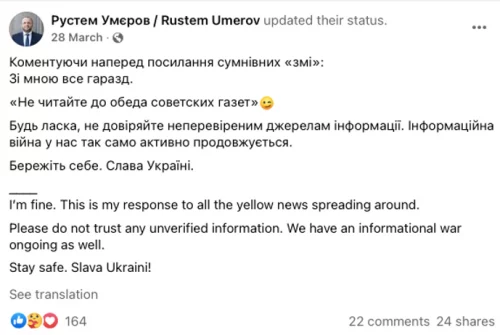
Reuter’s then reported that an unnamed U.S. official had stated that the symptoms exhibited by Ukrainian officials and Roman Abravovich were likely “environmental” and “not poisoning.” A spokesperson for Zelensky’s office, Ihor Zhovkva, told the BBC that the Ukrainian officials were “fine” and that the story was” false”. The claim has been denied by Russia, Ukraine and the U.S.
Western news outlets citing the Wall Street Journal or Bellingcat published the claims as if true and verified, which included the Daily Mail, The Week, France 24, ABC News and Bloomberg. In an article published by Forbes on 30 March they state that that “a source close to Roman Abramovich” had claimed that he had been poisoned.
Russia24 claimed that Roman Abramovich and Umerov had survived an unsuccessful assassination attempt. The host suggested that Umerov may have been the target because he allegedly witnessed the killing of a former Ukrainian peace delegate Denis Kireev, who was killed after he was accused of working with Russia. Boris Volodarsky a former captain in Russia’s special forces, the GRU Spetsnaz, who is now an intelligence historian and a Fellow of the Royal Historical Society in London, told Business Insider that “the reported poisoning of Ukraine negotiators” was “an FSB trick that worked well” and “boded well for the Kremlin.”
Ukrainian MP Lesia Vasynlenko tweeted an image depicting what she described as a “women with swastika shaped burns” – the image showed the torso of a female that appeared to have a swastika etched into it – she claimed the woman had been “raped and killed” by Russian forces. This image was shared again by one of Zelensky’s advisors Oleksiy Arestovych, who claimed that the image depicts “the body of a girl who was tortured to death in Gostomel.”
The image that Vasynlenko shared appears to be a taken from a video uploaded to Youtube by Patrick Lancaster, who is reporting from Russian-controlled territories and is embedded with the ‘DNR’ People’s Militia. The footage was apparently taken while searching a school basement in Mariupol, where it is alleged that the Azov Battalion were staying – the camera shows a member of the DNR militia states is Azov uniform found in the basement. In the video, Lancaster states that the swastika appears to have been “painted onto her stomach in blood” – the skin of her stomach looks as though it has also been cut. The Youtube video is not unavailable but clips of it can be found on Twitter.
The New York Post and The Huffington Post both published the claims without attempt to verify where they had originated from, apart from ‘reaching out for comment’:
‘Russians burned swastikas into victims’ bodies, raped girls as young as 10: reports’ – The New York Post
‘Russian Soldiers Rape Children And Brand Women With Swastikas, Ukraine MP Claims’ – The Huffington Post
Daily Mail, The Independent, Mirror and The International Business Times published this story, without mention of the original source, but presenting this as Ukraine v Russia narrative. Yahoo News, Metro and Newsweek all stated where the image originated from and that neither Vasynlenko nor Lancaster’s claims are verified, but their headlines read as if Vasynlenko’s claims were fact.
Other publications have taken the view that because Vasynlenko misappriated the image, its original source (Patrick Lancaster) must therefore be the truth: Lancaster’s version of events could well be false or staged by the ‘DNR’ People’s Militia with or without his knowledge.
Ukrainian Ministry of Foreign Affairs tweeted on 12 March “The mosque of Sultan Suleiman the Magnificent and his wife Roxolana (Hurrem Sultan) in Mariupol was shelled by Russian invaders. More than 80 adults and children are hiding there from the shelling, including citizens of Turkey.” 51 minutes later the Ukrainian Embassy in Turkey tweeted “The mosque of Suleiman the Magnificent and his wife Roksolana (Hürrem Sultan) in Mariupol was attacked by Russian invaders. More than 80 adults and children, including Turkish citizens, are hiding from bombardment.” Both used the hashtag #closeUAskyNow, which was used on social media during the period when Ukraine was appealing to NATO countries to implement a no fly zone over the country.
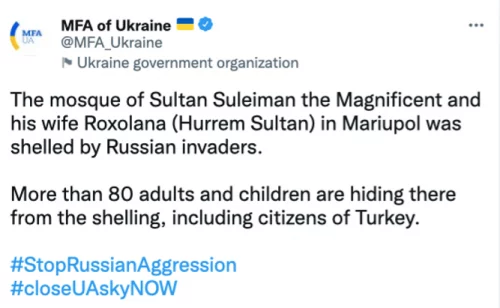
Within 2 hours of the Minstry of Foreign Affairs statement on Twitter, the Middle Eastern Eye reported that the president of Sultan Suleiman Mosque Foundation, Ismail Hacioglu had denied reports. “A bomb dropped 700 metres away from the mosque, but we are fine.”
France 24, Politico, Sky News Reuters and The Mirror all reported that the mosque had been shelled, after the president of the Sultan Suleiman Mosque Foundation had already denied the reports. Al Jazeera also reported false information but it is unclear at what time.
A tweet posted by the Russia Ministry of Foreign Affairs alleges that “During the course of the special military operation evidence of an emergency clean-up performed by the Kiev regime was found – aimed at eradicating traces of the military-biological programme, in Ukraine, financed by [U.S. Department of Defense]”. The tweet includes screenshots of documents, which are offered as ‘proof’.
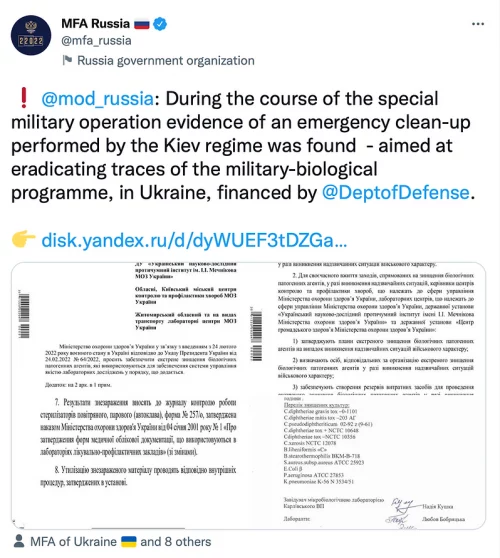
In a Telegram, Russian News Agency RIA Novosti published the first documents Russia said were evidence of biological weapons. These documents, which were issued on the second day of the Russian invasion contained orders from Ukraine’s health minister, directing labs in two cities, Kharkiv and Poltava, to destroy collections of bacterial pathogens used for research.
Maj. Gen. Igor Konashenkov, the Russian Defence Ministry spokesperson, told the Russia State News Agency Tass that the attempt to secure the labs was itself evidence that Ukrainian and American scientists had been secretly plotting to weaponise dangerous pathogens and in a briefing given 7 March, Igor Kirillov, the head of the Russian military’s radiation, chemical, and biological protection force, without evidence claimed that U.S.-funded labs in Ukraine and the former Soviet republic of Georgia were linked to a swine flu outbreak in 2007 and increased cases of measles, rubella, diphtheria, and tuberculosis in Ukraine.
An article published by The Intercept on 17 March, details how Russian biologists “at considerable risk to their own safety” have reviewed the documents presented by Russia as proof of a U.S.-funded biological weapons programme in Ukraine and have accused the Russian government of lying about having evidence to support their claims. In a change.org petition, one biologist asserts that the documents do not “imply any development of biological weapons or even the use of particularly dangerous pathogens in the laboratories. The list of destroyed strains published by RIA Novosti and other Russian media outlets contains not a single particularly dangerous strain. The list contains only strains common to microbiological and even more so to epidemiological laboratories.” Another group of 9 biologists has created a spreadsheet, which explains all of the strains mentioned in the documents presented by Russia.
The documents themselves appear to be in reference to the The Nunn-Lugar Cooperative Threat Reduction Program, which the U.S. has been open about and was “created for the purpose of securing and dismantling weapons of mass destruction and their associated infrastructure in the former states of the Soviet Union.” In Ukraine, the programme has run since the 1994 agreement, when Ukraine agreed to give up its remaining nuclear weapons. Under the same agreement, the U.S. Defense Department and the Ukraine Ministry of Health have had a partnership since 2005, as part of the U.S. Biological Threat Reduction Program, which exists to “counter the threat of outbreaks (deliberate, accidental, or natural) of the world’s most dangerous infectious diseases” and “reduce the threat of biological weapons proliferation.”
While the evidence Russia has put forward to back their bioweapons claim has been disproven, testifying at the U.S. Senate Foreign Relations Committee hearing on Russia’s invasion of Ukraine 8 March, the U.S. Undersecretary of State for Political Affairs, Victoria Nuland, stated that Ukraine has “biological research facilities”. She added that the U.S. is “working with the Ukrainians on how they can prevent any of those research materials from falling into the hands of Russian forces should they approach.”
Whilst Nuland’s acknowledgement falls far short of evidence to support Russian claims of US bioweapons development in Ukraine, some western media have rejected outright claims that the US is funding biolabs. A fact check by USA Today, for example, brands the claim “There are biolabs in Ukraine funded by the US government” as false. But the agreement signed in 2005 between the US Department of Defence and the Ukrainian government specifies that the former will provide up to $15 million in assistance and support for facilities which “may include, but is not limited to, cooperative biological research, biological threat agent detection and response, and assistance for improving biological material protection, control and accountability”.
It is also important to note that there has long been controversy over whether germ warfare research carried out by the US government (among others) pushes the limits of the Biological Weapons Convention.
Russian state new agency Tass has reported this as fact, asserting that bioweapons facilities were operating in around and in close proximity to Russia, also publishing a joint statement from Moscow and Beijing that the alleged “military biological activity of the US and its allies poses a serious threat for the national security of Russia and China”. RT have written multiple articles covering the allegations of a U.S.-funded biological weapons programme in Ukraine including as recently as 16 April, in an article that claimed Germany had “coordinated” with the U.S. on “‘military biological activities’ in Ukraine”. The official news agency of Beijing, Xinhua News Agency, published an article that claimed “U.S.-funded biological laboratories in Ukraine worked on establishing a mechanism “for the covert transmission of deadly pathogens.”
On 9 March 22, Fox News and Tucker Carlson used the statements of Victoria Nuland to claim that the Pentagon had been lying and that this was evidence of “secret labs” in Ukraine. An article published by NBC News on 14 March falsely claimed that the presence of biological research labs in Ukraine was a “debunked conspiracy theory”, while there is no evidence to support the claim that the US is funding a biological weapons programme in Ukraine, in their attempts to debunk Russia and the far-right, mainstream publications may have added fuel to the fire.
The Head of the Office of the President of Ukraine put out a statement on Twitter, saying “Just now, a powerful barrage is underway. A missile hit the place where Babyn Yar memorial complex is located! Once again, these barbarians are murdering the victims of Holocaust!”
Natan Sharansky, Chairman of the Babyn Yar Holocaust Memorial Centre said in a statement: “Putin seeking to distort and manipulate the Holocaust to justify an illegal invasion of a sovereign democratic country is utterly abhorrent. It is symbolic that he starts attacking Kyiv by bombing the site of Babyn Yar, the biggest of Nazi massacres.”
Ynet journalist and veteran war correspondent Ron Ben-Yishai, visited the site and found it undamaged. Speaking to the New York Times, the Deputy chief of the Memorial Center, Ruslan Kavatsiuk, said that the memorial was not damaged but that a building that the centre had plans to use as a museum in the future had been indirectly damaged as a result of a Russian strike that targeted a communications tower nearby.
The Conversation, The Independent and The New York Post have unamended articles on their sites with the disinformation that the memorial was bombed. On 26 March, Russian shelling caused damage to a menorah at the entrance to Drobitsky Yar memorial on the outskirts of Kharkiv. NBC, Insider, The Jerusalem Post, ARTnews and the Jewish Chronicle, double down by saying that it was the second Jewish memorial to be bombed.
On the first day of the invasion, the audio of a confrontation between Ukrainian Navy soldiers and Russian forces was obtained by news outlet Ukrayinska Pravda and widely shared on social media, in which Russian forces demanded the Ukrainians surrender – their response was “Russian warship, go fuck yourself.” That day Volodymyr Zelensky said that 13 soldiers on Snake Island “died heroically but did not give up. They will be awarded the title of Hero of Ukraine posthumously.” On 28 February, the Ukrainian Navy put out a statement saying that they were actually “alive and well” and had surrendered.
Politico covered the original story 24 February and then published a correction 28 February, but in an article titled ‘Get ready for a long war,’ published on 1 March, they wrote “Ukrainian border guards on Snake Island in the Black Sea became heroes for their defiance under fire,” with a link to the BBC’s coverage of the original story.
In a Telegram, posted to the channel of the People’s Militia of the DPR, they claimed that: “On February 22, Ukrainian saboteurs detonated a mine-explosive device on the Donetsk-Gorlovka highway. As a result of the terrorist act, three civilians were killed.” The Telegram was accompanied by images of the burned vehicle.
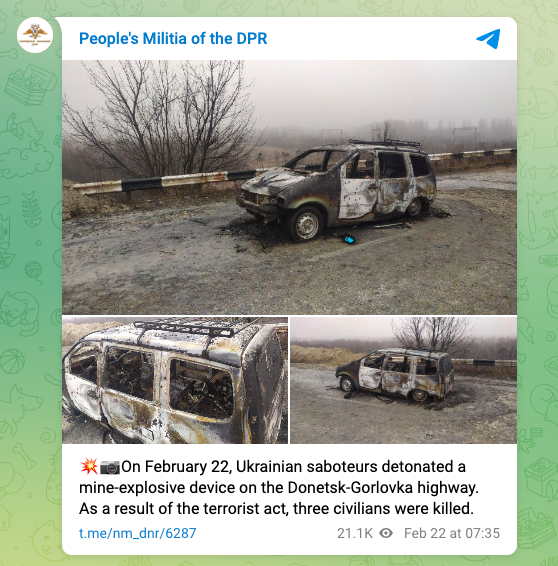
That same day, journalists from Russian news outlet, Izvestiya and US journalist Patrick Lancaster, both filmed the scene and uploaded images to YouTube, reporting that local authorities had referred to the blast as a “terrorist attack” by Ukrainian forces. The footage depicted graphic images of the human remains inside the vehicle.
In the high-resolution images uploaded to the YouTube channel of Patrick Lancaster, there are marks and cuts on to the bone that experts say is clear evidence that the person depicted in the image had died some time before there IED explosion. Speaking to Grid News, Victor Weedn, “a renowned career forensic pathologist with experience examining victims of IED blasts and former chief of the Armed Forces DNA Identification Laboratory” says that the incision on the skull of the front seat passenger, is consistent with those performed during autopsies, also noting a small hole that suggests an entrance an exit wound of a bullet. The vehicle depicted in the image also has no number plates; which is not immediately suspicious but in context raises considerable questions.
Russian state media reported that a car bomb had been detonated in the separatist region of Donetsk outside an administration building, alleging that the vehicle belonged to DNR militia leader Denis Sinenkov. Hours earlier, Denis Pushilin Head of the Donetsk People’s Republic warned that Ukraine could be planning an attack.
Online accounts were quick to raise questions about the validity of these claims. One user pointed out that the absence of fire or any signs of burning, which would indicate that there was no fuel in the vehicle at the time it was detonated and appeared to be unused.
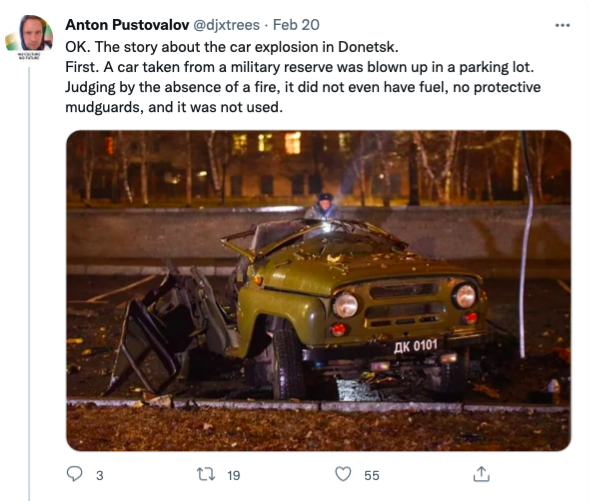
This user also highlighted an image published to an account May 31, 2021, which depicts a different vehicle with the same number license plate. The numbers and spacing appear to be different on the two license plates, indicating that one is a copy of the other.
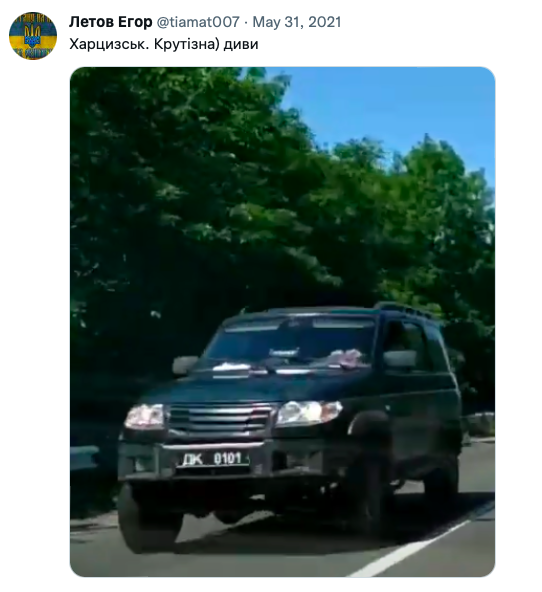
Prior to the bomb detonation on 18 February, the UK Foreign Office tweeted “Intelligence has exposed Russian plans to engineer a pretext for the invasion of Ukraine.”
In a Telegram posted to the channel of the People’s Militia of the DPR they stated: “According to our intelligence, saboteurs planned to blow up a container with chlorine on the territory of a sewage treatment plant near the city of Gorlovka.” In a subsequent Telegram message, they shared video footage which they clam depicts “Polish speaking saboteurs” attempting to blow up the chlorine tank and claimed that a security officer at the plant was injured.
Online accounts quickly debunked this footage and by checking the metadata, revealed that the footage was filmed 10 days prior to the date that it was posted on 8 February 2022.
